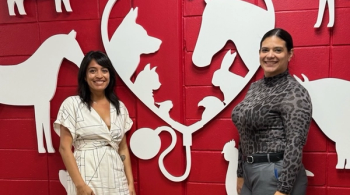
Wake up and smell the veterinary crisis
Let's stop blaming the economy and start focusing on the real issue at hand. There are just too many veterinarians on this earth.
In spite of the efforts of our profession's leaders, many veterinarians seem unaware or at least unconcerned that our beloved profession is in crisis. While I wouldn't want to deprive anyone of following his or her dream of becoming a veterinarian, there are simply too many of us to meet the existing demand—a demand that is shrinking.
Some 15 years ago, the American Veterinary Medical Association (AVMA) and American Animal Hospital Association (AAHA), along with the Association of American Veterinary Medical Colleges (AAVMC), commissioned a study by KPMG, "The Current and Future Market for Veterinarians and Veterinary Medical Services in the United States." The study was actually prompted by Malcolm Getz's book, Veterinary Medicine in Economic Transition (Wiley, 1997), which predicted an impending oversupply of veterinarians.
Contrary to the impression of many people, the study's findings indicated that there wasn't a surplus of veterinarians. In fact, the emphasis of the report was on economic concerns, and indeed veterinary incomes were a major concern of the profession. The mantra for veterinarians became, "Raise your fees and charges!"
However, there was one important tidbit from the study that was more or less ignored by the profession. It was the section that read, "There is evidence that in purely economic terms there is an excess of veterinarians, which is a cause of downward price pressure and is projected to result in stagnant veterinary incomes over the next 10 years. More important, the characteristics of the supply may not closely match the demand."
The study predicted a probable balance between supply of veterinarians and demand for veterinarians by 2014. This was predicted based largely on the steady numbers of veterinarians being produced by 27 U.S. veterinary schools. Well that was then, and now a lot has changed.
The problem with veterinary schools
The number of U.S. veterinary colleges represented in the AAVMC has just increased to 29, and that number will likely continue to increase compounded by increasing class sizes in existing schools. Even more concerning is the number of AVMA-accredited international schools—there are currently 18 (five in Canada, one in Latin America, five in Europe, five in Australia and New Zealand and two in the West Indies). Since the "Mega Study" warned us of this delicate balance, the number of veterinarians graduating in the U.S. has increased by more than 500 a year. In 1980, there were 32,500 veterinarians; by 2007 that number had increased to nearly 64,000. Today there are some 90,000 active veterinarians in the United States. And there is no end in sight.
During the same period that our professional population was exploding, a number of other factors have impacted veterinary medicine as well. Some of these factors have been attributed to a decline in the economy, but many are societal and technologic changes. They are independent of the economy except in that the recession fed an emphasis on alternative delivery sources and even a reduction in the perceived value of products and services. Pet owners simply reduced their dependence on veterinarians.
So what's all that got to do with us? Well, just about everything! Our planet is facing crises of excess—too many people, too much neglect and not enough resources. And most people believe that we, along with our descendents, will pay the piper. Winds are changing and tides are rising. Regardless of the cause, these changes will impact us for generations. For what happens to one of us happens to all of us.
If one veterinarian is struggling, we're all struggling, and there's a real oversupply of veterinarians. The recently published AVMA 2013 Veterinary Workforce Report finds that out of the more than 90,000 active veterinarians, fewer than 79,000 consider themselves fully employed, indicating a 12.5 percent excess capacity of veterinary services. Put more bluntly, this means one in eight of our colleagues is underemployed!
What my survey says
Over time, I've informally surveyed hundreds of veterinarians, and fewer than one in 10 have even read the summary of the Bayer Veterinary Usage Study released in 2011. Red flags have been flapping like pennants at a used car lot for some time as indicated by organized medicine and studies by dvm360. Yet veterinarians seem focused on the role of the economy, competition and the fact that "cats don't like to go to the vet."
Those same informal surveys are even more disappointing when I ask about the AVMA Veterinary Workforce Report. Everybody knows "business is slow," but few realize the breadth of the problem. I'm reminded of all the people who go to Las Vegas or other gambling meccas. At the end of the trip, everyone says they "broke about even." Really? Many veterinarians say they are seeing "about the same" number of patients as last year. Really? Take a look at your appointment book. Not many years ago appointments were scheduled every 15 minutes and it took days for clients to get an appointment. Today most practices provide appointments of 30 minutes or longer, and appointment schedules are hardly ever full. I suspect getting an appointment at the veterinary clinic is now easier than getting one at the hair salon!
How should we respond?
The first thing we need to do is to acknowledge the issue. While some veterinarians are up to their necks, many are feeling their socks getting wet, and as a whole the profession is "knee-deep in the big muddy." We can blame the economy. We can blame competitors. We can blame the manufacturers, the veterinary colleges, the legislatures and so on. But believing something doesn't make it true, and blaming others won't change the situation.
While veterinary revenues have been increasing recently, this follows on the tail of several years of decline. Therefore we're really only marginally better off than we were at the onset of the financial downturn. From my perspective the greatest hope we have is to find the fixable leaks and plug them.
Start by actively pursuing and promoting feline visits—do it now! The American Association of Feline Practitioners has an excellent model to improve the veterinary experience of cats and their owners. It's beyond the scope of this column to discuss specific recommendations, but read it and, more importantly, take the recommended steps. Don't stop at putting a towel on the exam table and hanging a couple of posters.
Be sensitive to pet owners' financial concerns. U.S. households spend more each year on pets than on alcohol, furniture, landline phone service or men's and boys' clothing, according to U.S. Bureau of Labor Statistics data collected by the Census Bureau. I've long been concerned that our ability to provide care was being outpaced by the cost of care. In fact, few of our own employees can afford our services without subsidy. What does that say?
We all want to provide the best care possible, but it's important to recognize that not everyone can afford or even wants the best care possible. Not all consumers will buy a BMW. That's why Ford makes the Fiesta. Support some form of pet health insurance and help clients budget their pet healthcare expenses by providing a wellness plan.
But most importantly, demonstrate the importance and value of your services. Position yourself and your practice as a trusted advisor, not a source of products that have become largely commoditized. Advocate for care rather than recommending products. Treat all clients as if they really matter. This will keep them coming back and keep our profession's world spinning—for at least a little while longer.
Dr. Michael Paul is a nationally known speaker and columnist and the principal of Magpie Veterinary Consulting. He lives in the British West Indies.
Newsletter
From exam room tips to practice management insights, get trusted veterinary news delivered straight to your inbox—subscribe to dvm360.






